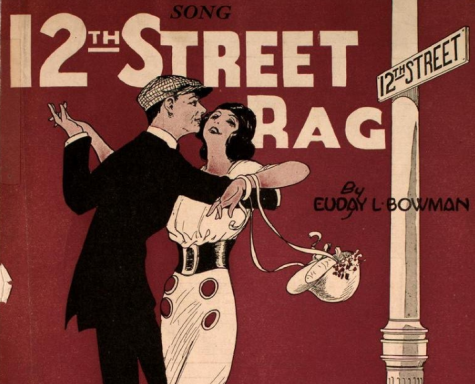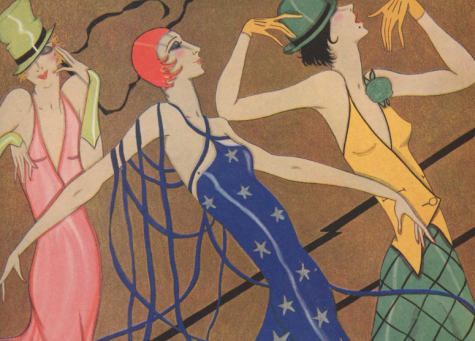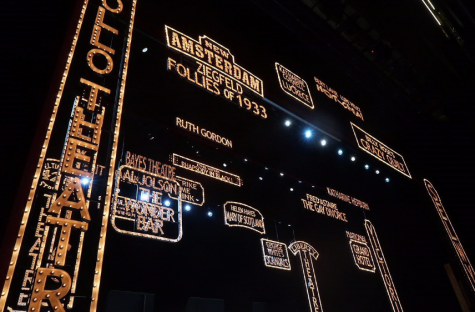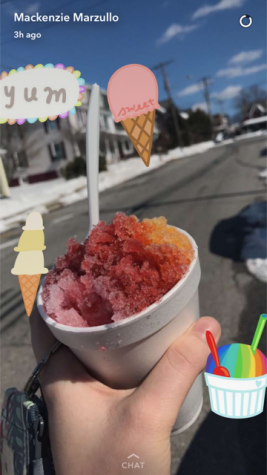The Evolution of Music: 1920-30s Make an Impact
February 25, 2019
Music is the one language that everyone speaks.
Throughout the decades, music has evolved and changed only to get better.
This series of articles will go through these legendary time periods and show how music has become the main focus of our world today.

Image Courtesy of: @JazzAgeMusic via Twitter
From the Jazz Age all the way to the beginning of glamorous Old Hollywood, music was becoming widely recognized in America.
With the prohibition of alcohol, many underground branches created small speakeasies which were filled with drinks and many different types of musicians.
The dancing within these speakeasies soon became a large part of the culture of the 1920s.
The “Charleston,” “Black Bottom,” “Shimmy,” “Foxtrot” and “Lindy Hop” were some of the most popular dances of the time.
Most dance music resembled what we would call big band today, but at the time it was considered jazz and had elements of the formerly popular ragtime music.
Jazz music began in the early 1900s within the black community in New Orleans.
It was a new type of music that combined European and African styles.
It is a difficult style to define, as it incorporates several different elements of several different styles, relies on a lot of improvisation and syncopated rhythms and is subjective in many ways.
Two predominant black artists were Louis Armstrong and Duke Ellington, and an influential white jazz artist at the time was Bix Beiderbecke.
Jazz gained popularity and spread through the country in clubs, speakeasies and dance halls where bands would play their new music.

Image Courtesy of: @Peepsqueak via Twitter
Many of the clubs were segregated and would only allow white bands in white clubs and black bands in black clubs.
Along with jazz was the introduction of what we know today as blues.
Blues likely originated earlier in the African American communities within the deep southern states of the US.
Songs would often show the singers’ personal troubles and the ongoing racial problems.
Mamie Smith made the first recorded blues vocal performance by an African American singer in 1920.
The song was called “Crazy Blues,” and it was hugely popular within the African American community.
Another important blues singer from the 1920s was the “Mother of Blues,” Ma Rainey.
She was also one of the first professional blues recording artists and was known for having a very powerful yet soothing voice.
Rainey was suspected by many to be bisexual or lesbian, and she is thought of as one of the first influential voices in the LGBTQ+ community as many of her songs openly referenced lesbianism.
With the beginning of the film industry and silent films, there slowly grew a need for music to be played along with the movie.
Prior to the creation of talking films, musicals were often originated in the theatrical Broadway area of New York City.
Broadway became a place where talented performers, composers, writers and musicians gathered to create new art together.
It came into its own during the 1920s and was a place where creativity and decadence thrived.
Broadway music found a home in the new synchronized sound films and America was introduced to a new and modern musical theater, a blend of classical and innovative musical styles, juxtaposed with exciting stories that reflected the current era.
Popular Broadway performers began making their way to the film and music recording industries where their signature performances could be distributed to the masses through movies and records.

Image Courtesy of: @42StreetLND via Twitter
Famous stars to emerge from the Broadway scene included Fanny Brice, Al Jolson, Sophie Tucker and Ethel Waters.
The 1930s were shaped by the contrasting moods of the Great Depression and the glamorous beginnings of Old Hollywood.
Popular music was equally impacted by these forces and as home radios became more common, the music industry began to keep track of the popularity of records through sales.
Jazz music evolved into different styles with swing and big band becoming prominent throughout the 1930s.
Musical films influenced pop culture and many film stars were also popular singers of the time.
Crooners soon grabbed the attention of a younger audience, and artists like Rudy Vallee were crowned as some of the first heart throbs, hosting their own shows on radio and making appearances in films all while churning out recorded hits of their own.
An offshoot of the previously popular jazz genre, swing music was developed near the end of the 1920s and it reached the height of its popularity from the mid-1930s to the early 1940s.
Swing differed from traditional jazz in that the songs would often have a stronger driving force.
They focused on the rhythm sections and allowed some improvisation while often featuring a soloist or vocalist prominently most commonly played on the trumpet.
The style was also adaptable with other genres as fusions with country and blues were also popular.
Many black bands were treated differently and denied credit and recognition for their contributions to the genre.
Segregation and discrimination in the United States prevented many black swing bands from reaching the pinnacles of their careers, but some band leaders like Cab Calloway and Count Basie and singers like Ella Fitzgerald and Billie Holiday attained mainstream success.
While thought of as a derogatory term for singers of sentimental pop and jazz standards, many “Crooners,” as they were called, became popular during the Thirties.
The genre fit well with the style of radio at that moment and created some of the first music heart-throbs, pop stars and teen idols of the time.
Artists like Bing Crosby, Russ Columbo, Hoagy Carmichael and Rudy Vallee best represented the mostly male-dominated genre.

Image Courtesy of: @WatchWhere via Twitter
Bing Crosby, while not necessarily a teen idol, was also considered a crooner and became one of the first multi-media stars.
He was one of the best selling musicians of all time and certainly dominated the charts of the 1930s.
Crosby got his start by recording with popular orchestras and soon found solo success with a weekly radio show.
He belted out his hits on the air, and they would quickly reach the top of the charts as listeners flocked to his distinctive bass-baritone voice.
Crosby began starring in several short films where he appeared as himself which helped launched his career.
He remained popular throughout the 1940s and 1950s, getting larger roles on screen and still making waves as a hit-making recording artist and performer.




